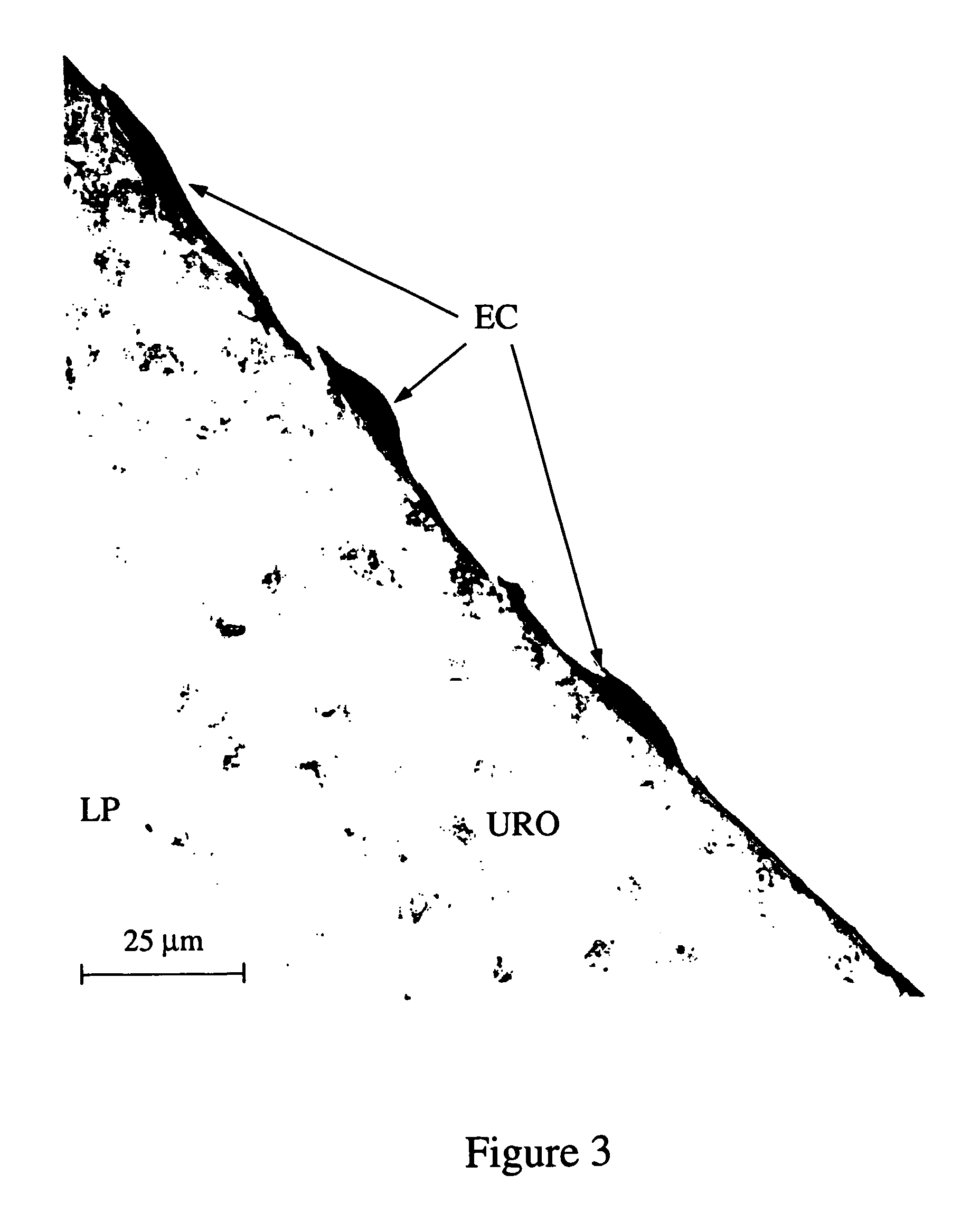Method of creating biological and biosynthetic material for implantation
a biosynthetic material and biosynthetic technology, applied in the field of biosynthetic material creation, can solve the problems of thrombosis and occlusion, lumenal narrowing, and inability to eliminate the degree of calcification
- Summary
- Abstract
- Description
- Claims
- Application Information
AI Technical Summary
Benefits of technology
Problems solved by technology
Method used
Image
Examples
example 1
[0041]The method of treating tissue according to this embodiment was applied to bovine ureters for use as vascular prostheses as follows.
[0042]Bovine ureters were collected under hygienic conditions and transported to the laboratory at 4° C. Physiological saline was pumped via the pelvic end of the ureter. The distal or bladder end was temporarily occluded and the pressure of the saline within the lumen was increased to 115 mm Hg. The diameter of the ureter at the mid point was recorded. A compr ssible silicon mandrel slightly narrower in diameter than the ureter and mounted on a blunt nosed steel introducer was inserted a traumatically into the pressure filled ureter. The metal introducer was removed. Excess tissue was removed from the exterior of the ureter. The ureter was then tethered to the silicone at one end, allowing some movement along the silicone. The mounted ureter was placed into a rotating drum at 12 rpm at a temperature of 21° C. The concentration of glutaraldehyde wa...
example 2
[0045]In vivo inhibition of calcification was assessed in greyhound dogs as follows.
[0046]Grafts of 6 mm internal diameter and not less than 10 cm in length prepared from bovine ureters according to this embodiment were implanted into the aorto-iliac position with the distal aorta to the proximal anastomosis ligated. Grafts of 4 mm internal diameter and not less than 6 cm in length were implanted as femoral interposition grafts.
[0047]No anti-coagulation or antiplatelet therapy was used.
[0048]Periodic angiograms were taken at predetermined intervals to verify patency and detect aneurysms, dilatation or stenoses. The animals were sacrificed at predetermined intervals, or at graft closure or animal distress.
[0049]Finally, macro- and microscopic examination of the explants were performed.
[0050]When patency, mural integrity and luminal integrity of implanted material processed by the current invention were compared with that of U.S. Pat. No. 4,466,139 neither was compromised. However, wh...
example 3
[0052]The attachment and adherence of human saphenous vein endothelial cells transplanted onto the surface of the processed bovine ureter were evaluated as follows.
[0053]Human saphenous vein endothelial cells were isolated, harvested and seeded using published or modified techniques. Human saphenous vein endothelial cells were isolated from inverted varicosed human saphenous vein segments obtained from the operating room and transported to the laboratory in chilled Hanks Balanced Salt Solution (HBSS, Sigma Australia) containing ampicillin (100 μg / mL), gentamycin (50 μg / mL), amphotericin B (2.5 μg / mL), L-glutamine (2.5 mM) and sodium bicarbonate (0.23%) and stored at 4° C. The ends of the veins were ligated with surgical silk. A modified enzymatic harvesting technique was utilized whereby the veins were immersed in 10 mL of 2 mg / mL collagenase (Worthington type IV, Sigma) for 10 minutes at 37° C. then vortexed on an automatic speed for 1 minute at 10 second intervals. The collected c...
PUM
| Property | Measurement | Unit |
|---|---|---|
| time period | aaaaa | aaaaa |
| temperature | aaaaa | aaaaa |
| temperature | aaaaa | aaaaa |
Abstract
Description
Claims
Application Information
 Login to View More
Login to View More - R&D
- Intellectual Property
- Life Sciences
- Materials
- Tech Scout
- Unparalleled Data Quality
- Higher Quality Content
- 60% Fewer Hallucinations
Browse by: Latest US Patents, China's latest patents, Technical Efficacy Thesaurus, Application Domain, Technology Topic, Popular Technical Reports.
© 2025 PatSnap. All rights reserved.Legal|Privacy policy|Modern Slavery Act Transparency Statement|Sitemap|About US| Contact US: help@patsnap.com



